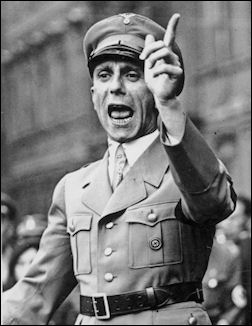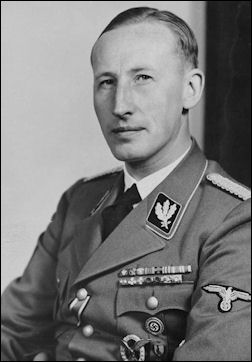
The Final Solution
From 1933 onward, anti-Jewish propaganda had flooded Germany. Under the skillful direction of Joseph Goebbels, his Nazi Propaganda Ministry churned out a ceaseless stream of leaflets, posters, newspaper articles, cartoons, newsreels, slides, movies, speeches, records, exhibits and radio pronouncements. As a result, the accusations, denunciations and opinions which Hitler first expressed in his book, Mein Kampf, had become institutionalized, accepted as time-tested beliefs by all Nazis, taught as fact to impressionable youths, and drilled into the minds of eager-to-please SS recruits.
Of particular note, was Hitler's oft-repeated claim that Jews everywhere were engaged in an international conspiracy to achieve world domination. In a speech given on January 30, 1939, commemorating the sixth anniversary of his rule in Germany, Hitler added a stark new warning: "If the international Jewish financiers in and outside Europe should succeed in plunging the nations once more into a world war, then the result will not be the Bolshevizing of the earth, and thus the victory of Jewry, but the annihilation of the Jewish race in Europe!"
Eight months later, when Hitler provoked a new world war as the means of achieving Lebensraum (living space) for his people, Nazi propaganda blamed the Jews for the war in addition to everything else they had been cited for over the years.
Hitler also believed the very presence of Jews in Germany and Nazi-occupied Europe posed a threat to German victory in the war. This was based on his experience during the First World War, when Germany had experienced a meltdown of civilian morale. In 1916, as a young soldier on sick leave in Munich, Hitler had been appalled at the apathy and anti-war sentiment he witnessed among German civilians. At the time, he concluded disloyal Jews had banded together and conspired to undermine the German war effort. And he was convinced they would do it again now if given the chance.
From the very onset of war, Hitler and his inner circle, including Göring, Himmler, and Goebbels, contemplated what to do about removing the Jewish menace, or "the Jewish Question." The attack on Russia in June 1941 raised the level of intensity concerning this unresolved issue. On the Eastern Front, the future of the thousand-year Reich was clearly at stake. Hitler therefore adopted a more radicalized approach in his rule as Führer to put all of German society on a war footing and to squash all obstacles in the path of victory. At this time, Hitler also radicalized his outlook toward the Jews in favor of a "Final Solution of the Jewish Question," in which the war against Nazi Germany's external military enemies would be expanded to include the internal arch enemy scattered throughout Europe and Russia – the Jewish population.
And so, at the behest of their Führer, a handful of Nazi bureaucrats conspired to bring about the demise of millions. On January 20, 1942, they attended the Wannsee Conference in Berlin, organized by SS-Obergruppenführer Reinhard Heydrich, who told them, “In the course of the practical execution of the Final Solution, Europe will be combed through from west to east.”
Heydrich revealed statistics indicating a total Jewish population of 11 million which included Europe and Russia. The initial goal, Heydrich explained, was to round-up and deport Europe's Jews to the already-established SS-run ghettos in Poland, where many would perish through harsh conditions including brute physical labor.
Inside the sealed-off ghettos, the Nazis reduced food rations to starvation level, an experience described by Sara Grossman, confined at age 21 in the Lodz ghetto: "I don't think anything hurts as much as hunger. You become wild. You are not responsible for what you say and what you do. You become an animal in the full meaning of the word. You prey on others. You will steal. That is what hunger does to us. It dehumanizes you. You're not a human being any more. Slowly, slowly the Germans were achieving their goal. I think they let us suffer from hunger, not because there was not enough food, but because this was their method of demoralizing us, of degrading us, of torturing us. These were their methods, and they implemented these methods scrupulously. Therefore we had very many, many deaths daily. Very many sick people for whom there was no medication, no help, no remedy. We just stayed there, and lay there, and the end was coming."
The ghettos, and the slow death they brought, were only part of the overall plan. In the months following the Wannsee Conference, three specialized killing centers, Belzec, Treblinka and Sobibor, were constructed in southeast Poland, featuring large gas chambers with adjacent crematories or burial pits for the disposal of corpses. After they became operational, the ghettos were bypassed and Jews went directly by train to the new death camps.
Nearby, at Auschwitz in adjacent Upper Silesia, a much larger killing complex was constructed. Auschwitz Commandant Rudolf Höss later testified that SS-Reichsführer Heinrich Himmler instructed: “The Führer has ordered the Final Solution of the Jewish question. We, the SS, have to carry out this order. I have therefore chosen Auschwitz for this purpose.”
Höss oversaw the rapid construction of a gigantic new annex called Birkenau containing four large gas chamber-crematory buildings and scores of huts for slave laborers. From the moment it became operational in the spring of 1943, Auschwitz-Birkenau served as the focal point of the Nazi effort to exterminate the Jews. Hour after hour, trainloads of Jews arrived from all over Europe. The people were subjected to a life-and-death selection process by SS medical personnel such as Dr. Josef Mengele. Adults who seemed fit for labor were allowed to live and were marched away. All others, including children, the elderly and anyone deemed unfit went straight to the gas chambers.
The SS used Sonderkommandos (Jewish slave laborers) during the gassing process to usher people in the undressing room and to clean up the gas chamber afterwards. One such survivor recalled the scene at Auschwitz: "There were all sorts of reactions from all sorts of people. There were disabled people. They would take out their war service cards showing that they had fought in the First World War with all kinds of distinctions and medals which they had from that time. They shouted, what's this? We fought for Germany. Now they're going to burn us, to kill us. This is impossible. We protest against such a thing. But everyone just laughed at them. Because they didn't take it seriously, these SS men. They laughed at the whole thing."
To remain efficient, the SS death factories required a steady supply of humans. To coordinate the flow of people to the gas chambers, Höss and fellow commandants relied on SS-Obersturmbannführer Adolf Eichmann, who became a central figure in the day-to-day management of the Final Solution. Present at the Wannsee Conference, Eichmann assumed the leading role in facilitating the deportation of Jews from every corner of Europe. With boundless enthusiasm for his task and fanatical efficiency, Eichmann traveled the continent, insuring that trainload after trainload departed. "The trains," Eichmann said later, "ran like a dream."
The SS organization also found it could profit financially from the human traffic. Upon arrival in the camps, all belongings were taken from the Jews. Foreign currency, gold, jewels and other valuables were sent to SS Headquarters of the Economic Administration. Wedding rings, eye glasses, shoes, gold fillings, clothing and even hair shorn from women also served to enrich the SS, with the proceeds funneled into secret Reichsbank accounts. Watches, clocks and pens were distributed to soldiers at the Front while clothing was given to German families.
To SS officials and the Nazi bureaucrats involved, it appeared the Final Solution was proceeding smoothly. In August 1944, Eichmann reported satisfactorily to Himmler that approximately 4 million Jews had been gassed while another 2 million had been shot in the East by mobile execution units.
By this time, news of the mass murders had leaked out of occupied Europe via first-hand accounts from eyewitnesses, escapees and other informed persons. Newspapers such as The London Daily Telegraph and The New York Times also published occasional reports of executions along with death toll estimates. World reaction to the reports changed little from what it had been to prewar reports of Nazi persecution – a few political speeches from Britain and America.
Inside the camps, the inmates fretted, as one Auschwitz survivor recalled: "We always used to say where is the whole world? Where is the United States? Where is Russia? And where are all those countries that could do something to help? Do they know what's happening here in the extermination camps at all?"
About this time, two Jewish inmates escaped from Auschwitz-Birkenau and made it safely to Czechoslovakia. One of them, Rudolf Vrba, submitted a detailed report concerning the gas chambers to the Papal Nuncio in Slovakia which was forwarded to the Vatican, received there in mid-June 1944. However, nothing came of it.
Throughout Nazi-occupied Europe, relatively few non-Jewish persons were willing to risk their own lives to help the Jews. Notable exceptions included Oskar Schindler, a German who saved 1,200 Jews by moving them from Plaszow labor camp to his hometown of Brunnlitz. The Nazi-occupied nation of Denmark rescued nearly its entire population of Jews, over 7,000, by transporting them to safety by sea. Italy and Bulgaria both refused to cooperate with Nazi demands for deportations. Elsewhere in Europe, people generally stood by passively and watched as their neighbors were marched through the streets toward waiting trains, or in some cases, actively participated in Nazi roundups.
Alone and against seemingly impossible odds, Jewish men and women struck back on occasion. In April 1943, Jews in the Warsaw Ghetto staged an armed battle against SS troops lasting five weeks. In October 1943, nearly 300 Jews and Soviet POWs overpowered guards and broke out of Sobibor death camp, which was then shut down by the SS. A year later, a revolt by Jewish slave laborers at Auschwitz-Birkenau resulted in the destruction of one of the main gas chamber-crematories. Elsewhere, Jews who eluded capture became partisans, particularly in Russia, where some 30,000 Jews fought alongside the Soviets to disrupt Hitler's armies.
After the German defeat at Stalingrad, the oppressed peoples of occupied Europe and Russia, including the Jews, could sense that Hitler's Germany was in decline. However, time itself had become an enemy for the dwindling number of Jews.
How long would it take the Allies to win – and would they still be alive when victory came?
Meanwhile they waited, trying with all their strength to survive just one more day – the slave laborers, the fortunate few still not discovered – and those confined in ghettos such as the teenager who wrote in her diary: “When we look at the fence separating us from the rest of the world, our souls, like birds in a cage, yearn to be free. How I envy the birds that fly to freedom.”
The Third Reich that Hitler had founded was intended to last a thousand years. But it was already tearing around the edges, confronted by an ever-growing force of nations rallying to smash Hitler's empire, on land, and on the high seas.
Copyright © 2010 The History Place™ All Rights Reserved
![]()
NEXT SECTION - Battle of the Atlantic
See also: The History Place - Holocaust Timeline
The Defeat of Hitler Index
The History Place Main Index Page
Terms of use: Private home/school non-commercial, non-Internet re-usage only is allowed of any text, graphics, photos, audio clips, other electronic files or materials from The History Place.


